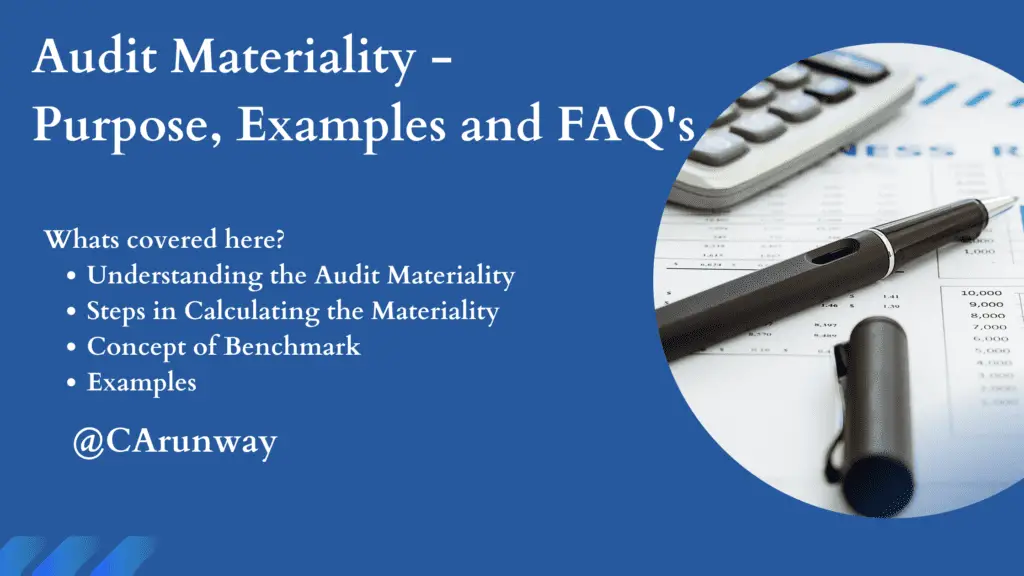
Audit Materiality means a quantitative value used to verify if an account balance or transaction is worth performing testing procedures in an audit context. There is no specific formula for arriving at the Materiality numbers, and it depends on who are the users of the financial statements under audit as well.
Estimated Time to read:
4 minutes
Table of contents
What’s the purpose of calculating Audit Materiality?
Given the time constraints, testing every transaction is not possible as part of audit of entities. Further, doing end to end transactions audit affects the Engagement economics as well.
So, the audit team needs a value to decide upon the significance of account balance or transaction for testing.
For example, if the GL balance is $1,000. Does this balance requires testing?
The answer would be no.
Such thresholds can be calculated only after considering the purpose of the financial statement from the standpoint of users of those financials.
For example, suppose the primary users of financials are Banks or Financial Institutions. In that case, they are interested in the Cash Flow available for financing activities or Profit before paying interest and taxes (PBIT). So, any of this will be an appropriate benchmark for calculating the Materiality in this scenario.
What are the steps in calculating the Materiality?
Based on the users of financials, The first step is to decide upon the benchmark, and then the second step is to apply a specific percentage on the quantitative value of the benchmark.
Here benchmark is an account balance or FS line item, on which a certain percentage is applied for arriving at the Materiality number. Let’s say, Equity balance is the benchmark. The audit team decides to use 5% of Equity as Materiality.
Also read the article on performance materiality for understanding the difference between materiality and performance materiality.
Runners Insight
How to arrive at Materiality numbers if there is more than one benchmark?
The procedure is the same as having one benchmark. After applying the above two steps, the numbers derived from both benchmarks are averaged to arrive at final figures.
Also Read: Distribution Journal Entry
Example:
Now, we understand the theoretical part of Materiality. Let’s see an example for calculating the materiality numbers.
The financial information of the “Flop Company” is:
- Profits before interest and tax = $5,000,000
- Cash Flows available for financing activities = $2,000,000
- Success Audit firm audits the Flop company for the first time.
Based on Auditors Professional Judgement, the Percentage considered for PBIT and CF are 0.5%-2% and 1%-3%, respectively.
Considering the history of misstatements and the first year of audit, the audit team shall use a lower Percentage for materiality calculation.
Benchmark Amounts:
PBIT Benchmark = $5,000,000*0.5% = $25,000
CF Benchmark = $2,000,000 *1% = $20,000
Therefore, the Average benchmark value = (25,000+20,000)/2 = $22,500
Runners Insight
Frequently Asked Questions
What about the qualitative factors for calculating Audit Materiality?
Qualitative factors such as research or analyst reports also play an important role in calculating Materiality. There isn’t any correct benchmark for all the audited entities, and the appropriateness of benchmarking varies from one entity to another one.
The other factors considered are the entity’s industry and the auditor’s professional judgment.
Runners Insight
Can Audit Materiality be set for a particular account balance?
The answer is yes. The team can calculate audit materiality for a specific account balance depending on the circumstances.
How about an example here?
Let’s assume that errors or misstatements were there in CY or PY for the Long-term debt. Then audit team notes that the Materiality set for financials will not be appropriate for this debt balance. This is because the materiality number is so high that it will not detect any errors or misstatements, which might affect auditors’ opinion on the financial statements when considered in aggregate.
Conclusion for Audit Materiality:
Audit Materiality is a quantitative value, which depends on the benchmark chosen and a percentage applied on the benchmark value. Materiality helps the auditor perform testing procedures only on the account balances that are of significance. Therefore, audit materiality is the one of the steps for planning audit.